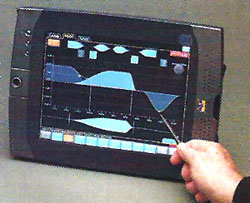INTRODUCTION TO THE LAKE CONTOUR
by Bruce Jackson
In 1997, I approached Roy and Troy Clair with an idea for a new digital solution that I believed could, if pursued, put Clair Bros ahead of their competition.
One thing I was bringing to the project was a history of developing products in the lab combined with decades of live sound mixing experience.
And, my long relationship with Roy and Troy, dating back to 1970 when I sold my sound company in Australia and came to the United States, helped convince them that my concept was worth exploring.
The vision that evolved in discussions with Roy was to fulfill a dream many of us have had, which, in a nutshell, is to have an ultimate remote control for live audio. Monitor mixers have long wanted to stand in place of the performer with all controls at their fingertips, while house engineers dreamed of walking to any position in the house with full control of everything in their racks.
Prior to approaching Clair Bros, I had begun working with David McGrath, co-founder of Lake Technology in Australia.
Before working with David, I thought I knew a thing or two about digital audio, but David is amazing. He’s a mathematical genius and also one of the best lateral thinkers I have ever met. We also pulled in Ed Meitner (an electronics whiz) of EMM Labs to work with us, so together we all formed Clair LLC with the intention of developing cool new digital technology.
A short time later, we were joined by Stewart Bartlett, who focused on hardware, and Marcus Altman, who served as software architect. A couple of years into the project, Jim Meyer of Clair Bros became an integral member of our small, tight-knit team.
We started out with a very ambitious set of goals, which required fundamentally different underlying digital signal processing. The user interface is based on my experience developing a computer game, and the desire for the unit to have a touch screen interface. Also, I didn’t want it to resemble “typical” Windows-based formats in appearance.
Many of you may have heard about the results of this labor, a device called the Clair iO, which up until now has been used by Clair Bros and Showco, exclusively. Now, however, we are able to offer this same technology in a new device we’re calling the Lake Contour. Justin Baird, Lake Contour product manager, will pick up the ball from here, taking you on a tour of the unit and technology.
WHAT IS A CONTOUR?
by Jason Baird
The Lake Contour is named for its unique sound reshaping capabilities, a package of hardware and software tools for live sound applications. Unlike other DSP-based loudspeaker controllers, Contour synthesizes filter responses on the fly, which supplies greater precision and flexibility in equalizing systems than found in current systems on the market.
This synthesis technology also supports an infinite number of EQ curves as opposed to the finite number imposed by parametric EQ sections or graphic EQ bands. It also permits the user to define the EQ curve they wish by layering multiple curves on top of each other.

For example, one could begin with a hidden complex curve to correct a loudspeaker’s phase response, and then a family of parametric and graphic curves can be added to more precisely mold the system’s response. The EQ’s total frequency response is a combination of all of the overlays.
The Contour Processor is a two-input, six-output unit utilizing extended precision 40-bit floating-point math to implement crossovers, dynamics, delays and EQ. Every internal calculation is performed with 40-bit extended precision. Multiple units can be grouped to provide multiple levels of control, and communicate over a standard Ethernet network.
The front panel of the unit has been kept intentionally simple because most functions are accessed via the Controller software. The front panel does include a push button that identifies the unit on the network and a four-character alphanumeric display that allows the user to both label the unit and scroll status information.





















